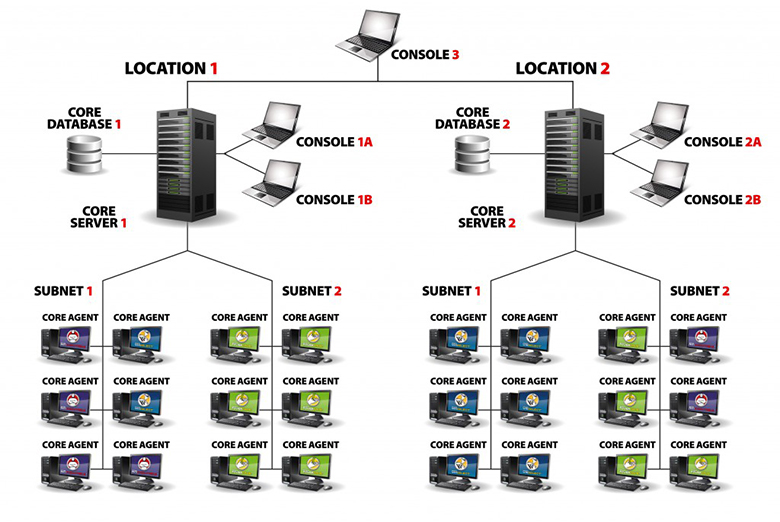
Faronics Core
Central control from one spot
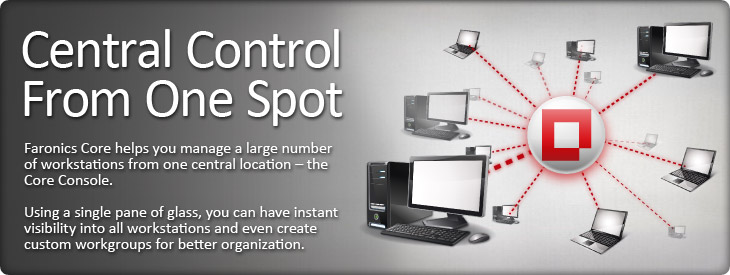
Overview:
Faronics Core provides enterprise deployment and management capabilities for Faronics’ software solutions. Faronics Core also allows the monitoring and management of multiple workstations from a central location. Faronics Core displays the current status of managed workstations and allows commands to be applied to one or more of those workstations. Faronics Core’s basic functionality is extended by installing Product Loadins. These Loadins extend the functionality of Faronics Core with product-specific status, actions and reports.
Faronics Core has the following components:
- Faronics Core Console (UI Tier) — The user interface used to manage and monitor Core Servers and workstations. A single instance of Faronics Core Console can connect to multiple Core Servers.
- Faronics Core Server (Logic Tier) — The management of workstations, processing of tasks and communication between Faronics Core Console and workstations is done by the Faronics Core Server.
- Faronics Core Database (Data Tier) — The database stores the workstation list and information about the workstation. • Faronics Core Agent — The Faronics Core Agent, that is installed on the workstation, enables communication between the workstation and the Faronics Core Database
The following diagram represents the various layers in Faronics Core:

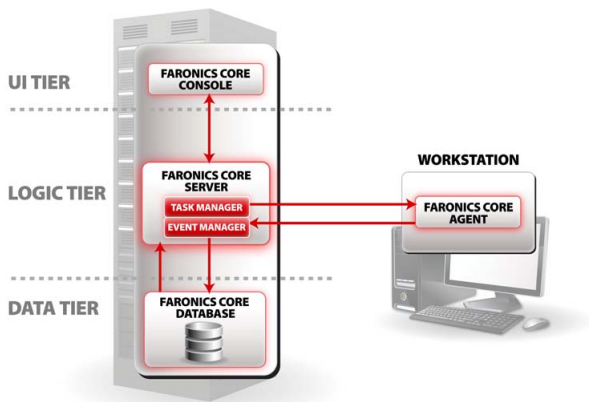
There are separate communication paths from Faronics Core Console to the Faronics Core Database, and from Faronics Core Database to the Faronics Core Agent.
How It Helps
Faronics Core is a multi-tool for IT professionals. It’s a simple remote management tool that makes it easy to centrally manage your endpoints. Equipped with enterprise-level deployment and management capabilities that can be customized for your organization, Faronics Core will save you time and money. It’s hard to believe, but Faronics Core comes with all Faronics enterprise solutions – free of charge.
With a large number of workstations to administer, you can appreciate the simplicity of managing multiple solutions through a single pane of glass. All workstation information such as name, online status, operating system, and more is easily visible from the Core Console. For even easier management, you can create custom workgroups to organize workstations in a way that makes sense to you. Faronics Core can host multiple product loadins at the same time to help you realize the value of your Faronics software investments faster.
Reclaim your time and let Faronics Core do all the heavy lifting. Using Faronics Core you can perform software deployments with a few clicks of a mouse or you can schedule them so they occur automatically after hours. You can also create customized policies to configure your Faronics products exactly how you want them. Your policies will be re-usable and will simplify the rapid configuration of new workstations. Faronics Core makes it easy to install and configure Faronics software but you aren’t limited to only that. You can also install third party products, update Windows and execute your own custom configuration scripts.
Faronics Core offers invaluable insight and intelligence with its built-in reporting abilities. You can run detailed reports on a workstation, group of workstations or even globally across multiple Faronics Core Servers. Faronics reports are exportable and can be easily published to the web or modified in spreadsheets. Each Faronics product has a full range of canned reports designed to give you a big picture view of your workstations.
Features:
- Windows updates are even easier to manage with Faronics Core. Using the MS WSUS™ you can pull updates for your endpoints and automate them with the handy scheduling function. For efficiency, you can also wake-up endpoints locally to grab the critical security patches and install them directly. Managing laptops? We’ve got you covered. The Active Task feature ensures IT tasks and configuration changes are applied even when not connected to the network. Once laptops come online, the changes are applied within two hours.
- Install with confidence across your entire organization. Using Faronics Core you can easily perform software deployments with a few clicks of a mouse. Or you can schedule them to occur automatically after hours. Simply set in and forget it. Plus, you’re not limited to only managing Faronics solutions. You can also install third party products, update Windows and execute your own custom configuration scripts.
- Faronics Deep Freeze integration allows you to make configuration changes to your Faronics software even while workstations are Frozen with Faronics Core. It also integrates with other Faronics software solutions so that you can manage them all from a single pane of glass, including Faronics Anti-Virus, Faronics Anti-Executable, Faronics Power Save, and Faronics WINSelect.
System Requirements:
System Requirements
- 32- or 64-bit editions of Windows XP SP3, Windows Vista and Windows 8.1
- 32- or 64-bit editions of Windows Server 2003 and Windows Server 2008, Windows Server 2008 R2
- The server requires Windows Installer (MSIEXEC) 4.5 and Microsoft MMC 3.0, which you must install separately (Faronics Core installer points to a download page if these components are missing).
- The server also requires Microsoft .NET 3.5 SP1 (which can be downloaded and installed by Faronics Core installer, if missing).
Hardware Requirements
- Minimum
- Pentium 4, 2.8 Ghz or equivalent
- 2 GB RAM
- 80 GB available hard disk space
- Recommended
- Dual Core Pentium 2.4 Ghz or equivalent
- 3 GB RAM
- 80 GB available hard disk space
Architecture:
Faronics Core consists of four components – Core Console, Core Server, Core Database and Core Agent. This tiered architecture allows for more flexible management and a more scalable system.
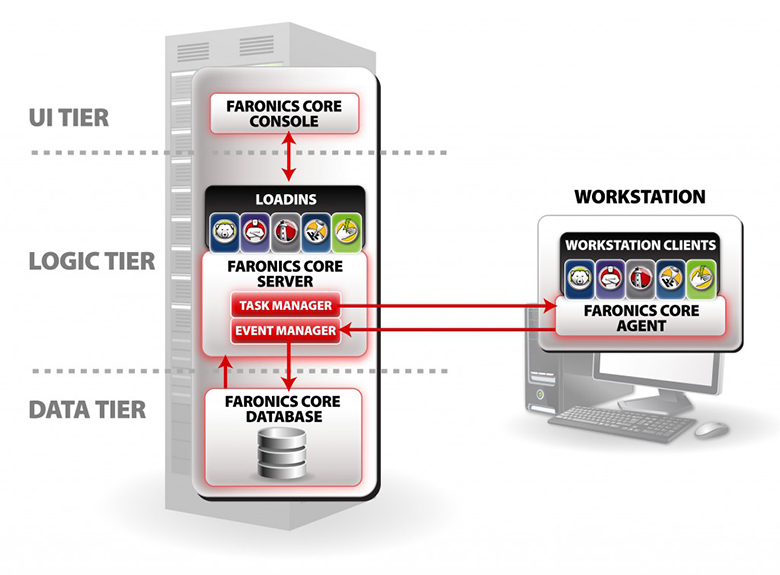
Multiple Consoles
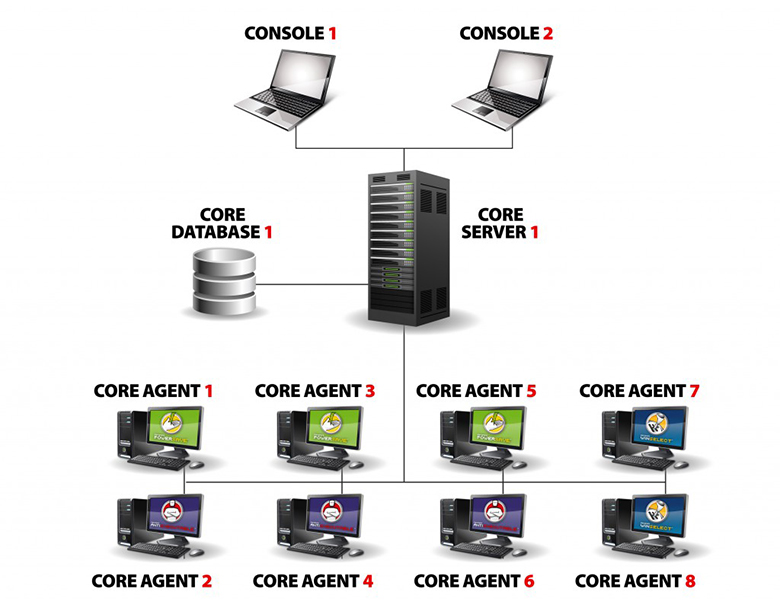
Multiple Servers
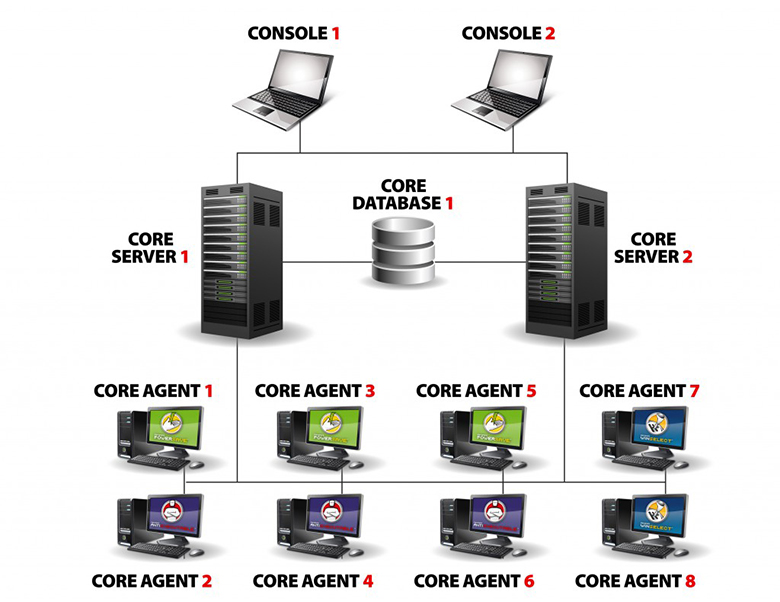
Enterprise Scalability
